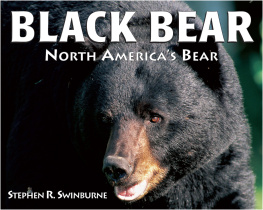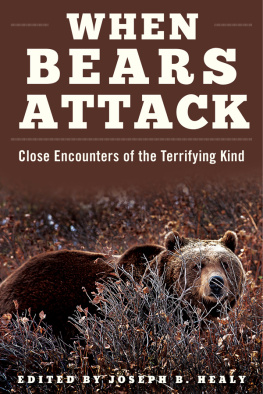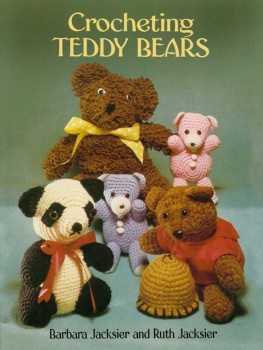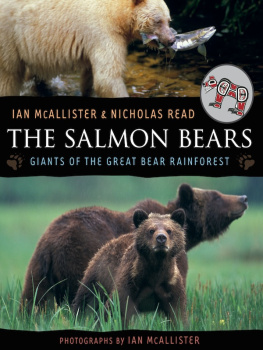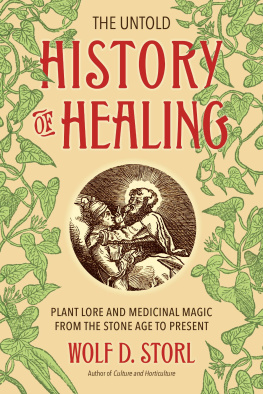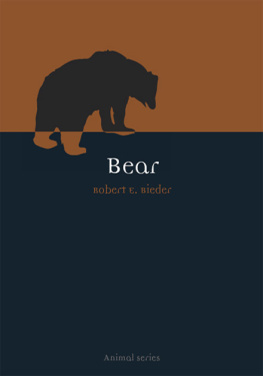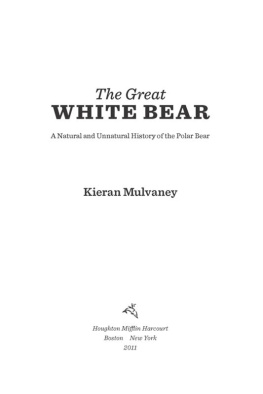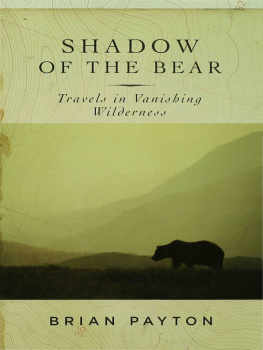
Copyright 2018 by Wolf D. Storl. All rights reserved. No portion of this book, except for brief review, may be reproduced, stored in a retrieval system, or transmitted in any form or by any meanselectronic, mechanical, photocopying, recording, or otherwisewithout the written permission of the publisher. For information contact North Atlantic Books.
Published by
North Atlantic Books
Berkeley, California
Cover design by Jasmine Hromjak
Book design by Happenstance Type-O-Rama
Printed in the United States of America
Originally published as Der Bar by AT Verlag. Translated from the original German by Christine Storl.
Bear: Myth, Animal, Icon is sponsored and published by the Society for the Study of Native Arts and Sciences (dba North Atlantic Books), an educational nonprofit based in Berkeley, California, that collaborates with partners to develop cross-cultural perspectives, nurture holistic views of art, science, the humanities, and healing, and seed personal and global transformation by publishing work on the relationship of body, spirit, and nature.
North Atlantic Books publications are available through most bookstores. For further information, visit our website at www.northatlanticbooks.com or call 800-733-3000.
Library of Congress Cataloguing-in-Publication data is available from the publisher upon request.
ISBN: 9781623171636 (print) | ISBN: 9781623171643 (ebook)
North Atlantic Books is committed to the protection of our environment. We partner with FSC-certified printers using soy-based inks and print on recycled paper whenever possible.
Poppies are blooming in the fields,
mountains are filled with song;
the blossom of our hearts,
dear bear, come and visit!
Russian Folk Song
Introduction
The more we get engrossed in time and hurry along with it, the farther away it takes us from the everlasting. This also applies as far as animals are concerned; never have we known more and (at the same time) less about them, never more regarding their anatomy and behavior, and never less regarding their divine nature, their pristine radiance of the creation. Fairy tales and myths reveal them to be miraculous and ancient; cults understand them to be divine beings.
Ernst Juenger, authors translation from Hund und Katz, 1974
I lived in bear country, in the Rocky Mountains and on the northwestern Pacific Coast, for about five years at various times, where bears, especially black bears, are still very present. In 1963, I spent about six months in the wilderness in Yellowstone where I met up with Bruin on a daily basis. The kitchen smells attracted bears; they sniffed curiously around doorframes and garbage cans. I met up with them on secluded hiking paths and always yielded them the right of way while admiring them from a respectful distance. While dozing near a campfire at night, I occasionally heard one sniffing and grumbling out in the darkness. I saw them with playful little bears splashing in the lake, swimming or fishing, saw them smacking their lips with pleasure in the berry bushes, saw their blue droppings full of digested blueberries and their paw tracks here and there on the muddy banks of streams. If one spends enough time in the wilderness, one begins to see bears as most Native Americans or other peoples who live close to nature in bear country doas magical beings, as humans in animal shape, possibly even as a teacher who can appear in dreams and somehow remind us of our own primeval, innocent, wild nature. It goes without saying that, in this way, one gets to know bears quite differently than in biology classes, at the zoo, or during a safari vacation.
Now I live near the Alps in southern Germany, near Switzerland. Here, there are beautiful mountains, lakes, and forests. It is wonderful to hike here, but something is missing, something that actually belongs to the countrythe howling of wolves that sends a chill up the spine on a full moon night, circling vultures above a dead wild animal, and the occasional bear ambling along the forest path. In our over-civilized world, too little takes our breath away, stirs up our archaic Neanderthal soul, or is able to awaken our awe for the creation. The virtual images of the ever-present entertainment industry can never replace genuine nature or wilderness without which our souls become impoverished. Everything is safetoo safe! Everything is controlled, scientifically documented, and schoolmasterly explained. Even the mountains and forests are becoming increasingly tamed. The old Squamish Chief See Yahtlh (a.k.a. Seattle) was right when he warned the white intruders: What is man without the beasts? If all the beasts were gone, man would die from a great loneliness of the spirit. For whatever happens to the beasts, soon happens to man (Seattle 1854).
Now let us ponder our brother and sister bear who have accompanied us along our pathway since the Stone Age, who send dreams and inspirations to medicine people and shamans, who give berserkers strength and courage, and who communicate knowledge to healers. I write as an anthropologist and touch upon not only the biological and ecological aspects of the bears being but also, and primarily, the ethnological and mythological ones. However, my concern is not simply one of information. I want to focus the bear into our consciousness so that we can dream him back into our hearts. And as far as Western Europe is concerned, we must even dream him back into existence.
Chapter 1
Bear Shamans and Plant Healers
The souls! They are not in the bodies. The bodies are in the souls!
Christian Siry, Die Muschel und die Feder
We have almost forgotten: animals are our helpers and companions. All too often we see them only in a utilitarian way. Cats are useful because they hunt mice, dogs protect property, cows produce milk, and horses are here for us to ride. But when we see animals with the eyes of the heart, we realize that their value cannot be expressed in merely economic and utilitarian terms. While studies have shown that children who grow up with pets are psychologically more well-balanced and that old people also fare better, especially if they are alone, with even just a goldfish or a bird, psychological well-being is not the aspect I want to emphasize. My area of interest goes into a much wider perspective, into the archetype of the animals, and, in this particular case, the mythological bear archetype.
Animals have very subtle senses and often sense what is approaching the people, or even other animals, they live with long before the people themselves become aware of something. It seems they can see into energetic, astral dimensions that are invisible to us. I believe that they even sometimes deflect the karmic suffering, or a similar serious illness meant for their owner, by taking it on themselves, even to the point of dying from it. Animal allies can help us understand and comply with our own fates better by communicating to us telepathically. Pets can do this, but wild animals are even more powerful because they havent been through the process of domestication. Some of us have close contact with wild animals and may have the opportunity to experience the phenomenon with deer, wild rabbits, coyotes, birds, snakes, and even tiny animals such as ants and bugs. For people who go far enough into the wilderness, contact with mountain lions, big game, and bears is possible.
In our schools, we do not learn about this connection to animal souls. Our attention is focused on other more important things, on lifeless mechanisms and abstract data, which makes it possible for us to function in the system. But the soul needs something else in order to be happy. Some of us are lucky enough to learn in childhood from relatives or friends how to connect with animals. But even beginner adults can connect with animals simply by opening their souls more when out in nature. Animal spirits tend to appear when we are open to them. Maybe a certain kind of animal has always interested you, or someone in your family knows about an animal that your ancestors were connected to or has always had a special friendship with your family.
Next page

